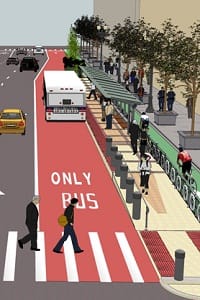World's cities look at how to keep moving, emit much less

 Persuading people — especially large new populations of first-time car-owners in developing countries — to drive their cars less won’t be easy. But it’s vitally important for reducing the risks of climate change, lowering dependence on oil and improving public health.
Persuading people — especially large new populations of first-time car-owners in developing countries — to drive their cars less won’t be easy. But it’s vitally important for reducing the risks of climate change, lowering dependence on oil and improving public health.
Globally, road transport is the second largest source of human-generated greenhouse gas emissions (GHG) after electricity generation. In the heavily car-dependent US, it accounts for 27 percent of emissions; even in more-efficient Europe, that figure remains close to 20 percent.
Although it’s a major cause of pollution — not to mention pollution-related health problems and road accident injuries and deaths — road transport also brings lots of benefits. So simply saying no to motorized travel isn’t a realistic option.
“Growth and development are primarily a matter of mobility. Mobility of people for access to employment, education and health, mobility of goods to supply the world markets that ensure the dynamism of economic activity,” states a recent report from the World Bank, “Turning the Right Corner: Ensuring Development Through a Low-Carbon Transport Sector.” “In other words, stop moving, emit less, is not an option.”
So if we can’t “stop moving,” what can we do? Lowering the carbon impact of transport is something that requires not just one approach, but many.
The World Bank’s recommendations? One, eliminate gas and diesel subsidies that make gas below-market cheap in places like Saudi Arabia. Two, set a price on carbon. And, three, signal the true costs of transport to users from local air pollution, time lost to congestion and injuries/deaths from accidents.
In 2007, for example, Beijing’s traffic generated $3.5 billion in health costs alone, according to the World Bank. Setting a price on such external costs could help cities and countries generate income they could use to invest in public transport and other efficiency improvements.
“Rough estimates of the revenue potential suggest that it could be even higher than the additional funding required for the low-carbon transition,” the World Bank report concludes. “If so, efforts to increase the efficiency of the transport sector could make it possible to reduce taxes that are harmful to growth and welfare. A broad agenda to make the sector more efficient provides far stronger incentives to reduce GHG emissions than a narrow climate policy program that implicitly assumes that all other inefficiencies have been removed. An efficient transport sector protects the environment and advances development.”
The right package of ambitious policies could cut urban transport-related emissions by up to 80 percent by 2040, according to German researchers.
Writing in the journal Environmental Research Letters, researchers Felix Creutzig, Rainer Mühlhoff and Julia Römer found that — added to existing demographic trends and improvements in fuel efficiency, three additional types of policies could help bring about large emissions reductions.
These policies include “pull” policies that attract commuters to low-carbon forms of transport like bicycles and bus rapid transit; “push” policies like congestion charging and reduced parking availability that discourage the use of polluting personal vehicles; and land-use policies that promote denser, more efficient development by prohibiting big-box stores in outlying areas or restricting new development only to areas served by public transport.
The result will vary according to each city’s existing infrastructure. Cities like Freiburg and Malmö, for example, could accommodate forms of transport where more than half the population could get around by bicycle. Larger cities like Barcelona and Sofia, on the other hand, could see more than 50 percent of trips handled by public transport.
Such transitions could also produce “significant concurrent co-benefits in cleaner air, reduced noise ambience, fewer traffic-related injuries and deaths, more physical activity, less congestion and monetary fuel savings,” the researchers write.
Hong Kong is among the cities that have already made a dramatic switch to large-scale, lower-carbon transport. By the late 1970s, it was growing by around 10 percent a year and had seen car ownership more than double over the previous decade. The city responded by — among other steps — improving public tranport, tripling the license fee for cars and doubling fuel taxes. By 1985, the number of private cars in Hong Kong was half what it was six years earlier.
A number of other cities that have improved their transport footprint are currently vying for the Institute for Transportation and Development Policy’s 2013 Sustainable Transport Award, to be announced Jan. 15. They include:
- Bremen, Germany, which has become a showcase for car-sharing;
- Lviv, Ukraine, which is launching smart traffic controls to prioritize public transport;
- Mexico City, which expanded its bus rapid transit and metro systems in 2012;
- Rio de Janeiro, which recently launched its first bus rapid transit corridor; and
- Rosario, Argentina, which is encouraging more cycling through a public bicycle system, new bike lanes, expanded bike parking and car-free Sundays on some streets.




